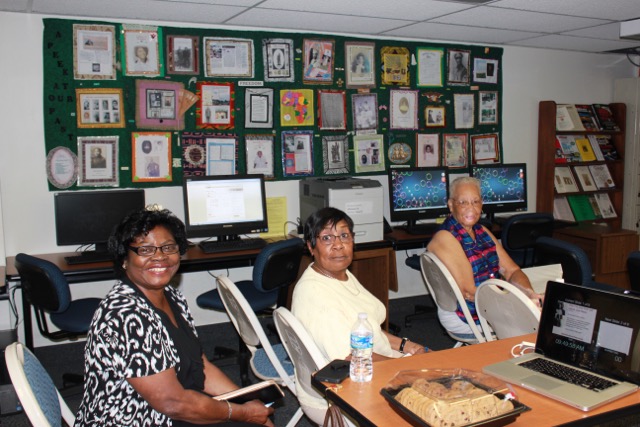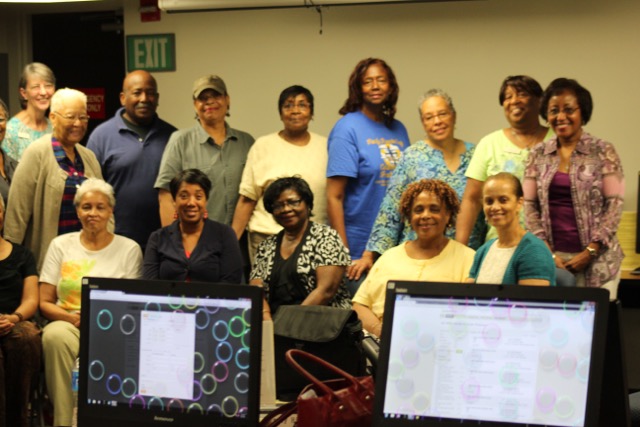| FHC Info | |
Hours of Operation:
Mon: Closed
Fri: 9:30 am-1:00 pm
Saturday:
9:30 am-4:30 pm
Tues, Wed, Thurs:
9:30am-4:30pm, & 7-9:30 pm
Directors: Linda & Kurt Christensen Washington DC Stake Carol & Gary Petranek, Silver Spring MDStake |
| Join Our List |
 |
|
|
|
WDC FHC News
| | |
Thursday Night Workshops
Skill Workshops will be discontinued for the summer.
Saturday Classes
Saturday, July 18, 9:30 a.m.
Rebecca Koford: Land Records: Rich Resources for your Research
Rebecca will explain indepth the type information in land records, where to find them, and how to use the data to further your research.
No Classes in August
Saturday, September 19, 9:30 a.m. (rescheduled from June)
Linda White, Co-Author: Back There, Then, a Historical and Genealogical Memoir
Linda will share her insights into composing a family narrative and organizing the myriads of pieces of information into a meaningful and well-written memoir.
Saturday, October 17, 9:30 a.m.
Charles Howard: City Directories
Often overlooked by researchers, city directories can offer more than just an address. Charles will demonstrate the many hidden clues found in this record collection.
Saturday, November 21, 9:30 a.m.
Denise Nelson: Precious Heirlooms, a Voice from the Past.
Items our ancestors treasured can tell us surprising facs about who they were, who hey associated with, their status, their ethnicity, their surroundings and their personal thoughts. Often neglected as a research tool, examining Gems and Jewelry owned by our ancestors provide us with a rather personal glimpse at our ancestors and their stories.
We invite you to join us! No registration is required. For further information, call the FHC at 301-587-0042 or email: info@wdcfhc.org
|
|
WDC FHC Focus Group Schedule
| | |
Join a Focus Group to Enhance Your Research Skills
African-American: weekly on Monday mornings at 10:00. Every 2nd Monday, there is special training to learn how to index Freedmen's Bureau records.
Beginning Genealogy: weekly on Tuesday mornings at 10:00. Contact Lorraine Minor at ldgene@verizon.net for further information.
DNA Group: Now on summer break; meetings will resume in September, bi-weekly the 2nd and 4th Wednesdays of the month at 7:00. Next meetings will be September 9 and 23.
Eastern European Group: Meetings are monthly on the 4th Saturday at noon; focus countries: Czech Republic, Poland, Slovakia, Hungary, Lithuania, Latvia, Estonia, Slovenia, Ukraine, and Belarus.
Irish Group: bi-weekly meetings on the 1st, 3rd & 5th Tuesday evenings at 7:00.
RootsMagic Users Group: Monthly meetings on the 2nd Saturday at 9:30 a.m.
All are welcome - no registration needed.
|
| Freedmen's Bureau Indexing Project | | |
by Carol Petranek and Bernice Bennett
On June 19, FamilySearch announced The Freedmen's Bureau Project at a news conference held in the California African American Museum in Los Angeles. This project will connect African Americans with their Civil War-era ancestors through the release of 1.5 million digitized images containing 4 million names from the Freedman's Bureau.
The Freedmen's Bureau Project was created as a set of partnerships between FamilySearch International and the National Archives and Records Administration (NARA), the Smithsonian National Museum of African American History and Culture, the Afro-American Historical and Genealogical Society (AAHGS), and the California African American Museum.
Sherri Camp, vice president of genealogy of the Afro-American Historical and Genealogical Society, said her group's 30 chapters across the country are excited to participate in the indexing project. "We're partnering with FamilySearch to get volunteers in all of our chapters across the country to have indexing groups so that we can get these records done."

Bernice Bennett, founder of the WDCFHC African American Focus Group, shared this information about the WDCFHC's initiative to support this project: "The African American Special Interest Group of the Washington DC Family History Center hosted a meeting today [June 22] on The Discover Freedmen Indexing Project. In attendance were representatives of five AAHGS Chapters (Baltimore County, Prince Georges County, Central Maryland, Montgomery County and Washington, DC). Also present were representatives from the Maryland State Archives and the general community. Following the meeting, the Special Interest Group agreed to continue to offer indexing training and support every second Monday for anyone interested in participating in the project."

For information about the Project and how to volunteer, go to http://www.discoverfreedmen.org/
To contact the WDCFHC African-American Focus Group, send an email to: AFAMGG@G-mail.com
To read the Washington Post's article about this initiative, click here.
Photos courtesy of Bernice Bennett
|
|
Freedmen's Bureau Indexing Video
| |
|
| | Discover Your Roots Using the Freedmen's Bureau Records |
|
|
10 Important Clues in Deeds
| | |
by Kimberly Powell
Deeds and other land records are an important part of building any family tree. Outside of telling you what land your ancestors may have owned, and where it was located, deeds are also a potential source of information on family members, family relationships, and other locations in which your ancestor lived. Each time you read a deed for your ancestor, ask yourself the following questions.
1. Is your ancestor selling property?
2. Where is the property located?
3. What is the date?
4. What was the purchase price?
5. Are there multiple grantors (sellers)?
6. Are adjacent landowners mentioned by name?
7. Who else is named?
8. Is there a release of dower rights?
9. Did he sign with an X?
10. Have you read every word?
Click here to read this detailed and informative article.
Source: genealogy.about.com
|
|
| | |
by Jim Bartlett, DNA Specialist
[Note: To help readers better understand the use of DNA in genealogy research, this newsletter will feature extracts of monthly posts from Jim Bartlett's new blog, Segment-ology.]
Why Upload to GEDmatch or FTNDA?
What is the advantage of uploading AncestryDNA results to GEDmatch and/or FTDNA? Let me count the ways... Here are my top 10 reasons.
[1]. To get additional Matches. (from other companies, including Matches below thresholds)
[2]. To get Matches with emails. And most at FTDNA have real names; many at GEDmatch have real names.
[3]. To get cooperative Matches. A much higher percentage of folks who test at FTDNA will work with you on genealogy. Same with folks who have taken the trouble to upload to GEDmatch.
[4]. To see the shared DNA segment. This is probably the most important reason, IMO! For each shared segment with a Match, you see the chromosome number, start and end locations, cM value, and number of SNPs included. This is technical DNA info, but it is invaluable to those who utilize the DNA beyond just a list of Matches (who may or may not be related - read on...)
[5]. The shared segment data allows the tester, or a Match, to confirm the segment is a true segment from an ancestor (that the segment is Identical By Descent, IBD) - this is done by Triangulation with other shared segments
[6]. The shared segment data allows the tester, or a Match, to evaluate the segment - a small segment indicates a distant relationship; a large segment, or multiple segments, indicates a closer relationship.
[7]. The shared segment data allows the tester, or a Match, to group segments from Common Ancestors - you will tend to have only one (or very few) different segments from a distant ancestor, and this is where you will find other cousins from that ancestor.
[8]. With Colonial American ancestry (and other endogamous populations), you may have multiple Common Ancestors with a Match. The shared segment data will allow you to determine which ancestor the DNA came from, because all who have the same shared segment data should descend from the same Common Ancestor.
[9]. Admixture (ethnicity, ancestral geography) reports are different at different companies. GEDmatch, in particular, has several utilities with a range of admixture evaluations that target different areas.
[10]. GEDmatch has other utilities, including seeing if your parents were related.
Source: Segment-ology, June 11, 2015
|
|
Research Reports for Research Success
|
|
by Elizabeth Shown Mills, author, Evidence Explained
The research process has three basic steps: preparation, performance, and reporting. If we use database management software or spread sheets, we add a fourth: data entry. In the popular mindset, Steps 2 and 4 get all the hype. News flash, everyone! It is those neglected Steps 1 and 3 that determine our success long-term.

In a soundly executed project, a block of research begins when we have defined an objective-not when we have a few spare minutes to spend surfing the web. Every block of research will begin with a document, a problem, an hypothesis, or some combination of these....
The Research Cycle
Research is a cyclical process, not a linear one. When we launch a new project we define our goal, both immediate and long-term. We develop a research plan, execute that plan, evaluate the results, and then develop a new plan for going forward with the project. In most cases, we repeat this cycle many times before we achieve our long-term goal. If that goal is a broad one, we will likely accumulate a massive amount of data across time, in which case each research report is a foundational document to which we return over and again to study group activities in a targeted area or to probe our past work for insight after new cycles of research have revealed more about our subject. If our research is a problem-resolution project, our cyclical process becomes a spiral in which the circles constantly tighten until eventually it closes in upon a body of evidence that suggests a credible solution.
To read the full article with detailed explanation of the four steps of the research process, click here.
Source: Evidence Explained blog, Quick Lesson 20, May 23, 2015
|
|
Bible Records from DAR Library Searchable
| |
The Daughters of the American Revolution (DAR) Library now has an online index of over 40,000 digitized family Bible records, and each day more records are digitized and added to the Index. This is one of the largest known collections of such genealogical materials in existence. The DAR collection spans many decades, so even those researchers who are not looking for Revolutionary War era ancestors, may find the new Bible Records Index useful (www.dar.org/grs/bibleindex)....
To use this new database, researchers will enter a name and the GRS will search the more than 40,000 Bible records for a match. If a match is found, the researcher will see information about the record including: surname, the source, book title, book description and the page on which the name first appears. If the researcher is on-site at the DAR Library they are able to view the Bible records and print off the pages that are needed. If the researcher is not at DAR Headquarters they can use the DAR Library Search Service to acquire the records or they can start planning their trip to the DAR Library so they can access the records.
To read the full article, click here.
Source: Eastman's Online Genealogy Newsletter, June 4, 2015
|
|
5 Tips for Resolving Evidence Conficts
| |
by Michael LeClerc
One of the great benefits of online research has been the search hints offered by websites. These are tremendously helpful, and can point you in directions you might not have thought to look. But at the same time, it is critically important to review this hints before blindly adding the information and/or individuals to your family tree.
One of the biggest issues we have is conflicting evidence. Sources often provide contradictory facts. We have to evaluate the sources as well as the evidence in order to come up with a theory. Here are some guidelines to keep in mind when evaluating your conflicting evidence.
1. Quality vs. Quantity
2. First-Person Accounts Aren't Always Correct
3. Lineage Societies Are Not Infallible
4. Conflicts Can Occur In a Single Source
5. Sometimes There is No Resolution
To read the full article, click here.
|
| Our Farming Ancestors | | by D. Joshua Taylor
...A large majority of our ancestors in the United States were farmers, as estimates count the number of farmers as 64% of the population (4.9 million) in 1850, slightly down from the figure of 72% of the population reported in 1820. While the life of my crooked politician is well documented, the lives of so many of my farming ancestors remain a bit of a mystery. They did not often make the county history book or the local newspaper, yet were an essential part of their local economies and deserve some recognition.
The tradition of the family farm is strong among many of our ancestors, and while fewer family farms can be found today than many years ago, they still remain an important concept for any genealogist to understand.
To access the post with links and detailed information, click here.
Source: JSTOR Daily |
|
Genealogy Tip of the Day
| | | by Michael John Neill
That Stone May Have Waited
Your relative's tombstone may not have been erected immediately after her burial. Consequently, various details may have been given to the stonecutter from a memory which may have not been precisely accurate. Court records indicate one relative who died in 1888 did not have a stone erected on her grave until 1906. Is it possible your ancestor's stone was erected decades after his death, perhaps with information submitted by someone whose memory was not quite accurate?
Did They Get Rehitched?
Don't assume because a couple got married and divorced that they never married again. My ancestor and her second husband divorced in the 1870s only to married again in the early 1880s and divorce again a year later. The second divorce record references the first marriage and divorce. An aunt divorced her first husband in the 1860s and took him again as her fourth husband in the late 1870s. If the remarriage is subsequently later or in a different locality the records may be more detailed than when the couple first married.
1920 Census Occupation Codes
Who Bought It?
When reading through estate records and inventories, pay close attention to those individuals who are buying property from the estate. There is a good chance that they are relatives and neighbors. In more recent times the names may not be a dramatic revelation, but in an earlier era it may help you to establish geographic proximity of two individuals..
What Kind of Courthouse Copy Is It?
When obtaining a copy of a deed record from a courthouse, don't forget that the deed in the courthouse is a record copy. In the early days of record keeping, those deed copies were handwritten or typed transcriptions. Later courthouse copies of deeds were made by some sort of photographic process. It's not the original deed in the courthouse-it's a transcription or a reproduction. The original was retained by the person obtaining the property, just like today.
|
|
Research Tips & Resources
| |
Delaware 1868 "Hundreds" Maps
If you have ancestors in Delaware, this link will provide pdf versions of "hundreds" maps: http://www.dgs.udel.edu/delaware-1868-hundreds-maps
Baltimore Family History Workshop
German Abbreviations If you are translating German documents, the following may be helpful: http://www.german-translation-tips-and-resources.com/german-abbreviations-1.html 1909 Street Name Changes in Chicago This document, from the Chicago History Museum website, provides a list of the changes in street names in Chicago in 1909: http://www.chsmedia.org/househistory/NameChanges/start.pdf Cuban Genealogy Collection Online This article explains the information released by the Florida International University Library: http://www.genealogyblog.com/?p=35137 |
Thank you for subscribing to Generations. We hope this publication will motivate you to successfully begin or continue your family history research. We would like to hear from you! Please submit your questions, research tips, and favorite websites to us at info@wdcfhc.org
Sincerely,
Carol Petranek, Newsletter Editor
Linda & Kurt Christensen
Gary Petranek
Co-Directors, Washington DC Family History Center
10000 Stoneybrook Drive, PO Box 49
Kensington, MD 20895
|
|
|
|
|